What happens when a drone hits a kite line? ….Or even a drone hitting a kite….?
As a frequent kite flier and Kite Aerial Photographer (KAP) these questions have come up over time …. And with the rapid increase in the number drones in the skies above….it was time to get some answers (or at least some data) to understand the risks and most likely outcomes of a drone striking a kite line….or even a kite!
Drone drivers also have similar concerns….getting tangled with kite lines….where in certain regions of the world…. young children …. chase drones with their small kites….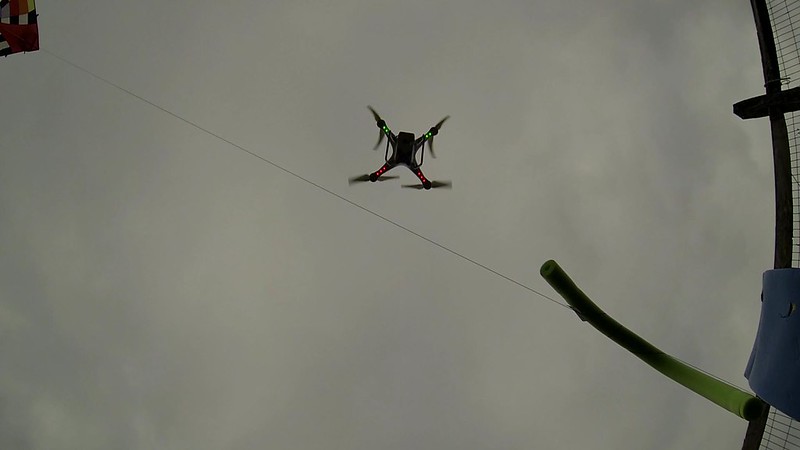
Purpose:
Test what happens when a drone strikes a kite line. Observe what happens when a drone flies into a kite line. Test three different types of kite line. Will the drone:
• Cut the kite line?
• Get tangled in the kite line?
• Bounce off the kite line?
• Have no impact?
Unplanned purpose.
• What happens when a drone directly collides with a kite?
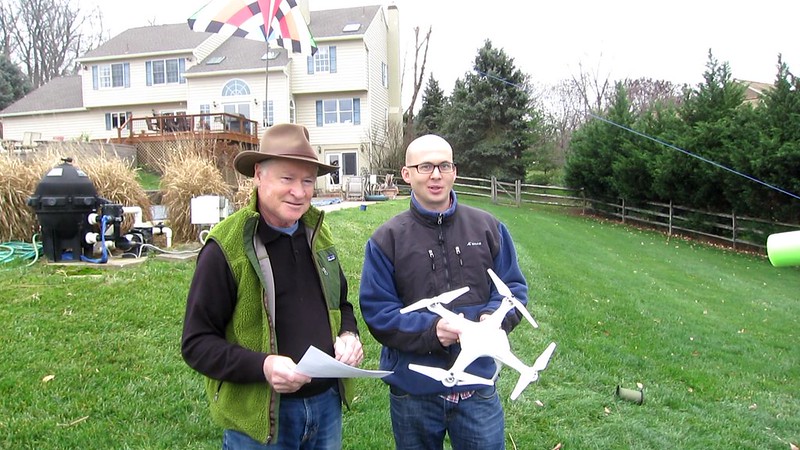
Experimental Conditions:
• DJ Phantom 2 drone
- Camera and gimbal mounts were removed to reduce potential damage to this equipment
- Intermittent error messages with GPS sync that caused some initial flight control issues
• A 9-foot delta kite (ITW Levitation Delta kite) attached to a 20-foot aluminum pole (to hold a fixed position in the sky…simulating a kite in the sky)
• Kite Line (three different line materials used):
- Braided Dacron 1.4mm 150 lbs.
- Braided Polyamide 1.5mm 150 lbs.
- Braided Dyneema 0.8mm 150 lbs.
• Kite line was attached with simple larks head slip knot to the Levitation delta kite
• Tension on the kite line was simulated by hanging a 2.5 lbs. weight on the other end of the kite line after passing through a Harken pulley that was attached to a fence rail.
• Line angle from the ground to the kite was approximately 30-45 degrees (started testing at 30 degrees, moved to steeper angle of 45% halfway through the testing).
• Foam padding and a foam swimming noodle was wrapped around the lower end of the kite line to protect the drone from striking the fence.
• The planned contact point between the drone and the kite line was intentionally placed low to the ground for two reasons: a) reduce damage to the drone and b) keep the contact point close to the video cameras that were used to document the experiment.
• Documentation of the Kite vs. Drone experiment was collected via multiple video cameras each capturing different points of views. Cameras used included:
- Gro Pro Hero3 shoot 2.7 K video
- Canon S100 shooting HD Video
- Apple iPhone 6 Plus shooting HD video and slow motion HD video 240fps
- Samsung Galaxy Note 4 shooting HD video and stills
• Safety glasses were used to protect eyes
• Location – Wind Watcher proving grounds Chester Springs, PA
• Test date: 16 December 2015
• Weather: Light wind out of the North West at 5-10 mph, temperature 50-55 degrees F with cloudy overcast skies.
The following photo shows the rough test conditions with the Levitation delta kite suspended on a pole with a kite line attached to the kite on one end and attached to the fence with a 2.5 lbs weight providing a constant pull. You can see the kite line (Dyneema) wrapped around the pool noodle.
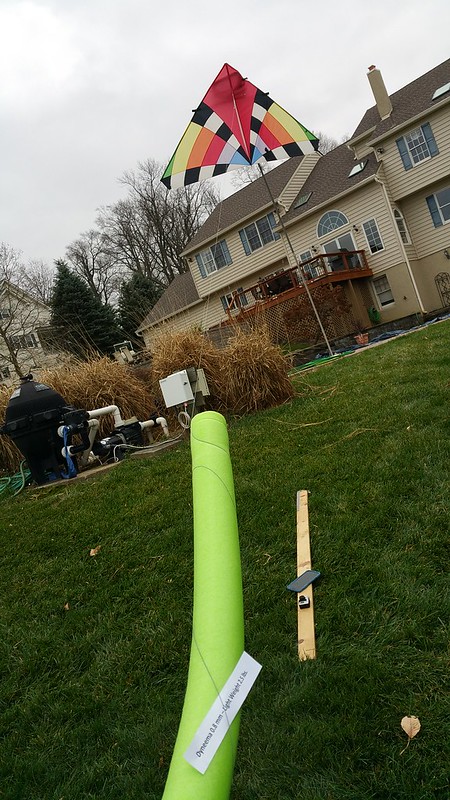
Test Sequence:
• First test sequence employed the braided Dacron 1.4mm 150 lbs. Kite line and 2.5 lbs line tension.
- Piloted line contacts (3)
- Hand held drone with line cut attempts (4)
• Second test sequence employed the braided Polyamide 1.5mm 150 lbs. kite line and 2.5 lbs line tension.
- Piloted line contacts (2)
- Hand held drone with line cut attempts (4)
• Third test sequence employed the braided Dyneema 0.8mm 150 lbs. kite line and 2.5 lbs line tension.
- Piloted line contacts (2)
- Hand held drone with line cut attempts (5)
Data:
Test data was captured using video, slow motion video (240 fps) and still photography. A total of 4 individual cameras were used to record each drone – kite line contact point attempt. Observations were also recorded on paper notes. A total of 77 data files (mix of video, slow motion video and still images) were collected totaling 1.8 GB data.
Test Results – Kite vs. Drone
First Test Sequence: Drone vs. Kite with braided Dacron 1.4mm 150 lbs. kite line with 2.5 lbs line tension.
Driving the drone into the kite line proved a bit difficult as the GPS stabilization mode was acting a bit flakey making it hard to hit the thin kite line. Two attempts were needed to hit the kite line using a slow forward motion of the drone.
As the drone slowly approached the kite line the props were slightly above the kite line. The lower body (legs) of the drone contacted the kite line causing the drone to rotate as it pulled against the kite line. The drone tipped up a bit and the back left prop hit the kite line with multiple strikes prior to the prop wrapping up the kite line and flipping over. The drone then ran into the safety foam noodle that was wrapped around the kite line. The foam noodle did sustain several deep cuts from the high speed drone props as it tumbled to the ground.
The following photos show a typical drone encounter with a kite line: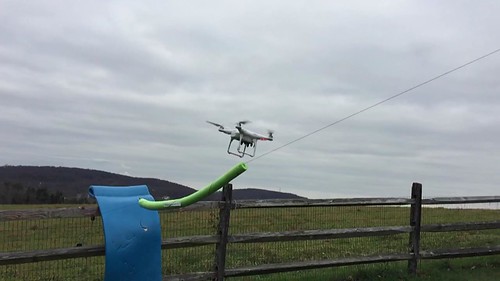
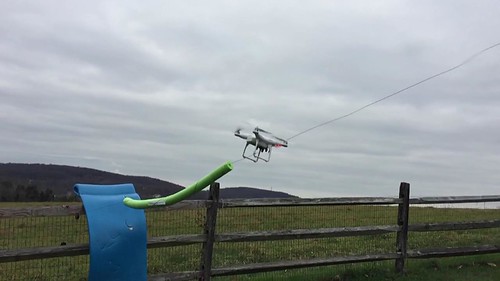
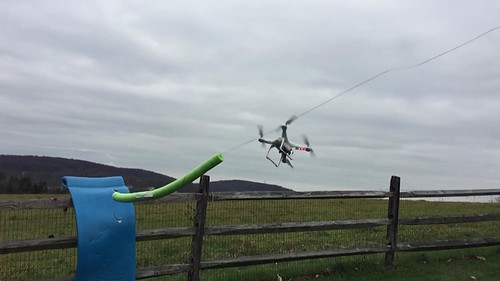
The kite line did not get cut by the drone high speed props.
The drone electronics seemed to detected the contact with the kite line and depowered the prop with the line contact. This caused the lift to drop under that prop. The drone rolled to over and crashed to the grassy ground below. No damaged was sustained to the drone from the short 4 foot drop to the ground (soft grass).
The Dacron 1.4mm kite line remained intact with no obvious visual damage.
Multiple experiments continued with drone vs. Dacron kite line with similar results.
• Under direct pilot control the drone either wrapped up the kite line or bounced off the kite line. The wrap vs. bounce outcomes appeared to be related to the angle of first contact.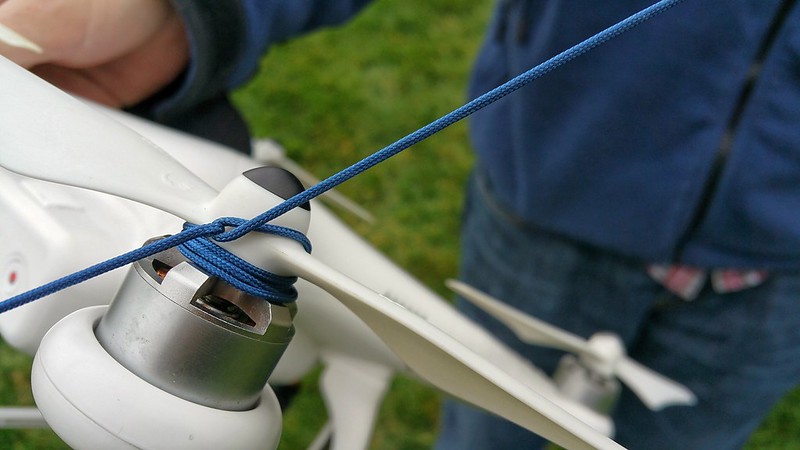
The next phase of testing took a more direct approach to challenging the kite line with one person (kite pilot) manually holding the drone while the drone pilot accelerated the drone motors to near maximum speed with the remote control unit.
I describe the technique used as the “Chainsaw” approach where a person holds the drone firmly in two hands with the drone blades running a full speed. The drone is then tilted to a vertical orientation relative to the horizon like holding a chainsaw and slowly moved directly into the suspended kite line with the objective of cutting the kite line with the tips of the high speed props.
Multiple attempts to cut the Dacron kite line with the direct “Chainsaw” approach failed. The drone upon striking the kite line with the tip of the prop blades either bounced off or wrapped up the kite line around one of the props. Basically using the high speed drone prop blades as a high speed cutting tool.
No visual breaks or cuts were observed in the Dacron kite line. Close examination with macro photography revealed minor abrasion marks on the braided Dacron in several locations.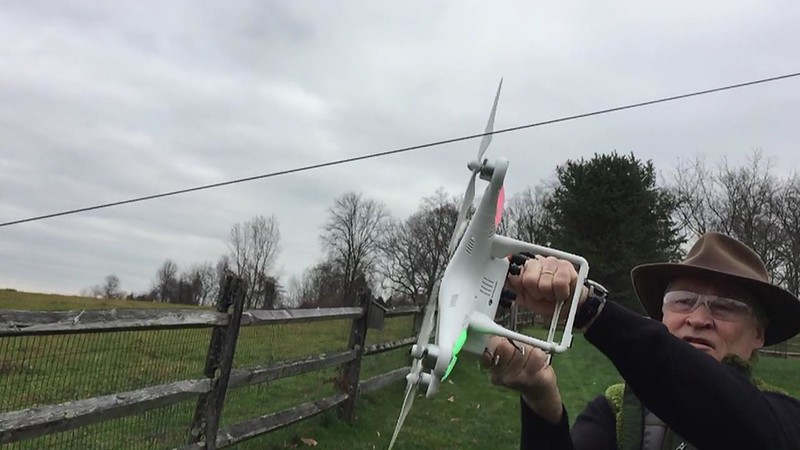
Drone Strikes Kite
During the 1st test sequence with Drone vs Dacron kite line the drone unexpectedly veered off course, rose up and struck the kite attached to the top of a 20-foot pole simulating the kite in the sky. This was not a planned test step.
The drone cut across the front of the kite with the prop blades slashing into the rip stop nylon fabric in several locations. The drone then hit the kite line flipped over and had a hard crash down on concrete below. The hard impact of the drone hitting concrete dislodged the battery and a prop from the drone. A few tense minutes passed as the drone was reassembled and checked out OK to continue the Drone vs. Kite testing. The Levitation delta kite did not fare as well with several large gashes in the light weight rip stop nylon fabric.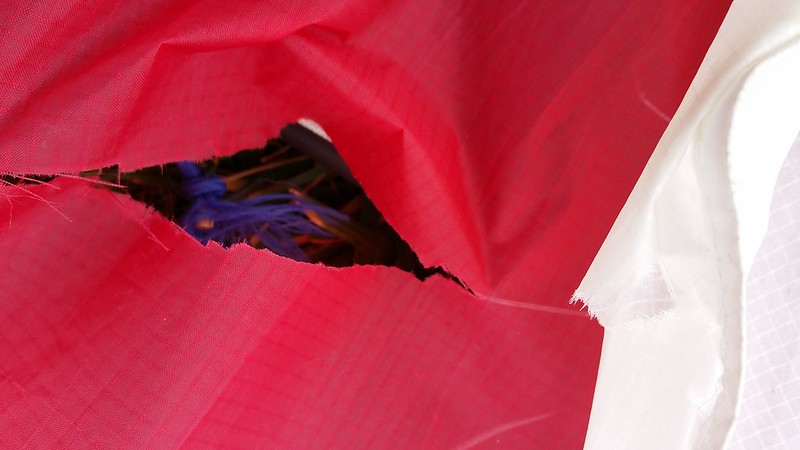
Second Test Sequence: Drone vs. Kite with braided Polyamide 1.5mm 150 lbs. kite line with 2.5 lbs. line tension.
The line attached to the kite was switched to the second of three materials (Braided Polyamide 1.5mm 150 lbs.) and the drone vs. kite line challenge was resumed. The braided polyamide material has greater elasticity (~30%) and a much looser braid.
The same test techniques were employed for the Braided Polyamide kite line (piloted drone line contacts and “chainsaw” direct cut attempts).
Test results were the same as for the braided Dacron kite line.
The drone wrapped the kite line around the high speed props about half the time with both piloted and “chainsaw” techniques. The braided polyamide kite line held up the best with no visible evidence of wear or cuts upon both visual and macro photographic inspection.
The drone behavior during contact with the Polyamide 1.5mm kite line remained the same as for the Dacron kite line. Upon contact with the kite line the drone intelligent circuits appear to reduce power to the prop which causes the drone to roll over and crash to the ground. When the drone bounces off the kite line it re-establishes level flight.
Third Test Sequence: Drone vs. Kite with braided Dyneema 0.8mm 150 lbs. kite line with 2.5 lbs line tension.
The line attached to the kite was switched to the third of three materials (braided Dyneema 0.8mm 150 lbs.) and the drone vs. kite line challenge was resumed. The braided Dyneema material is very thin and slippery with a very tight braid. The drone pilot had a hard time seeing the very thin kite line.
The same test techniques were employed for the braided Dyneema kite line (piloted drone line contacts and “chainsaw” direct cut attempts).
Test results were the same as for the braided Dacron kite line.
The drone wrapped the kite line around the high speed props about half the time with both piloted and “chainsaw” techniques. The braided Dyneema kite line held up with no cuts or breaks. The braided Dyneema did have several small nicks or abrasion points visible upon inspection and with the more detailed macro photographic inspection.
The drone behavior during contact with the Dyneema 0.8mm kite remained the same as for the Dacron kite line. Upon contact with the kite line the drone intelligent circuits appear to reduce power to the prop which causes the drone to roll over and crash to the ground. When the drone bounces off the kite line it re-establishes level flight. 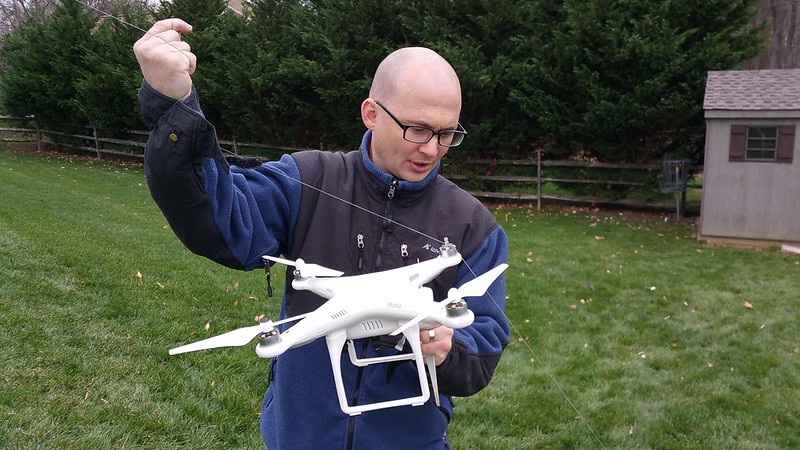
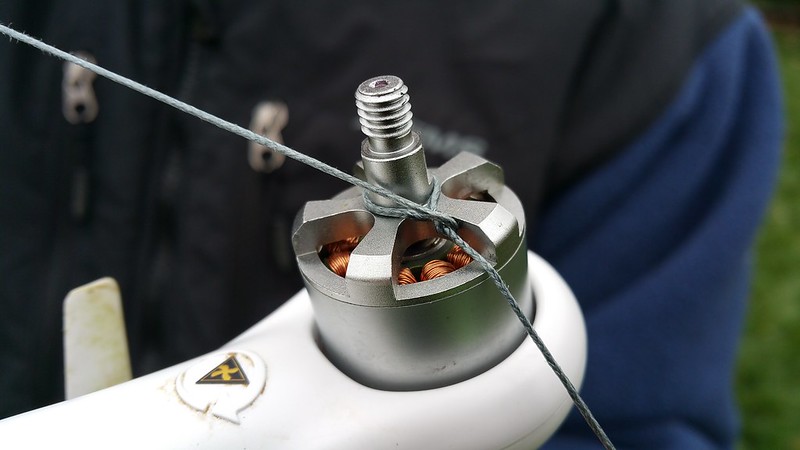
Summary & Conclusions
• Kite line is tough and is not easily cut by high speed drone prop blades. The drone was unable to cut any kite line in any of the experiments conducted.
• All three kite line materials held up with the following rough ranking for least evidence of wear to most (based on macro photographic inspection see below):
- Braided Polyamide 1.5mm 150 lbs. – no evidence of wear
- Braided Dacron 1.4mm 150 lbs. – trace evidence of wear
- Braided Dyneema 0.8mm 150 lbs. – minor nicks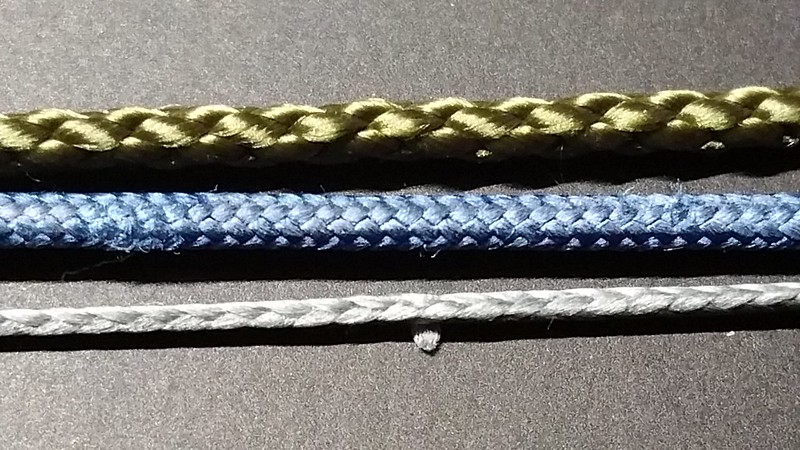
• Kite fabric (light weight rip stop Nylon) is easily cut if the high speed drone prop blades directly contacting the Nylon fabric.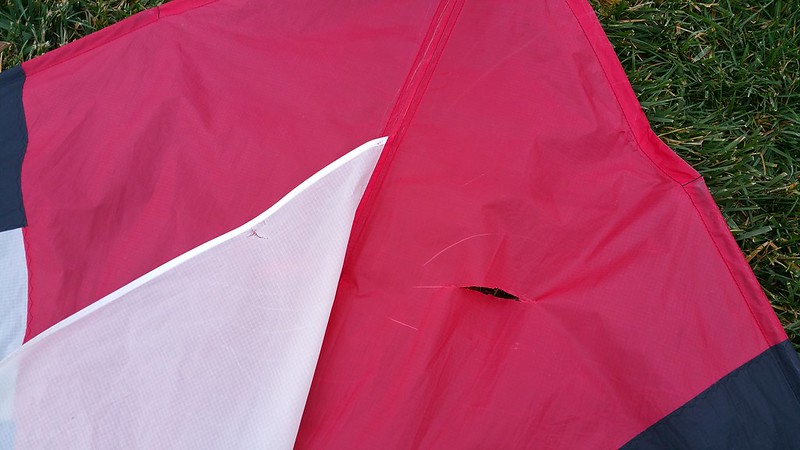
• Drones (at least some) appear to have quick acting logic to de-power a prop rotor if it senses contact with an object. This preliminary observation need to be confirmed. This makes sense from a safety design point of view.
If a drone contacts a kite line the following outcomes are expected based on this limited experimental data:
• The kite line will wrap around the drone prop. The drone will stay affixed to the kite line and either stay in the sky or slowly sink to the ground depending on the pull on the kite line (from the kite in the sky) and the overall weight of the drone.
• The drone will bounce off the kite line and momentarily roll and fall from the sky (due to a power down of one or more props). Depending on the altitude it is unknown if the drone could recover orientation quickly enough to regain leveled flight. Experiments with drones hitting kite line several hundred feet up in the sky were not performed during this series of tests.
If a drone directly contacts a kite (the actual fabric that the kite is made of) the following outcomes are expected based on very limited experimental data:
• The drone high speed prop blades will cut the lightweight rip stop Nylon fabric or plastic. Depending on the extent of damage the kite most likely will become unstable and slowly fall from the sky.
• The drone may become entangled with the kite fabric, bridles and or framing and fall from the sky with the kite.
Future
Additional testing of kite vs. drone is anticipated with high speed drones passes directly contacting the kite line with the expectation that the drone prop blades would be running at near maximum rpm.
Thanks to Jon Iannacone for being the drone pilot and putting his drone at risk during these interesting Kite vs. Drone experiments over the Wind Watcher proving grounds.
Supporting Data:
• High resolution images can be found here on flickr
• HD and 2.7K video with additional commentary can be accessed here on YouTube
Kite vs. Drone - Part 1 - Introduction -
Kite vs. Drone - Part 2 - Dacron -
Kite vs. Drone - Part 3 - Bottom View -
Kite vs. Drone - Part 4 - Bottom View -
Kite vs. Drone - Part 5 - Line wrap -
Kite vs. Drone - Part 6 - Drone hits kite line
Kite vs. Drone - Part 7 - Drone Hits Kite -
Kite vs. Drone - Part 8 - Summary -
• Copies of the raw data sheets can be viewed here on flickr
Enjoy the video and still photographic data.
Enjoy the flying and fly safe (both drone and kite pilots)!
WW
Reference section:
Kite FAA regulations:
Kite Aerial Photography safety tips:
Drone FAA regulations:
Drone FAA regulations:
Drone safety tips:
Drone safety tips:
Replies
interesting . I snag my glider into the kite line once and it flat spin. good thing I manage to recover it.